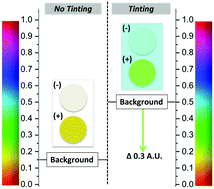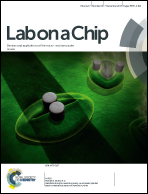Color manipulation through microchip tinting for colorimetric detection using hue image analysis†
Abstract
Colorimetry with microfluidic devices has been proven to be an advantageous method for in situ analyses where limited resources and rapid response for untrained users are desired. Image analysis using a small camera or cell phone can be easily incorporated for an objective readout, eliminating variations from normal differences in color perception and environmental factors during analysis. The image analysis using the parameter hue, for example, has been utilized as a highly effective, objective analysis method that correlates with the psychological way color is perceived. Hue analysis, however, is best used for colorimetric reactions that result in distinct changes from one color to a markedly different color and can be inadequate to distinguish between subtle or monotonal (colorless-to-colored) color changes. We address this with three unique color manipulation (i.e., tinting) techniques that provide greater discrimination with such color changes, thus yielding improved limits of detection for various colorimetric reactions that may have previously been limited. Tinting is invoked through dyeing the reagent substrate, colored printing the device, or colored lighting during image capture, and is shown to effectively shift the background color of the reaction detection area. Hydrogen peroxide, a constituent of peroxide-based explosives, is associated with a monochromatic color change upon reaction, and this is used to demonstrate the effectiveness of the tinting methods in improving the limit of detection from an undetectable color change to 0.1 mg mL−1.



 Please wait while we load your content...
Please wait while we load your content...